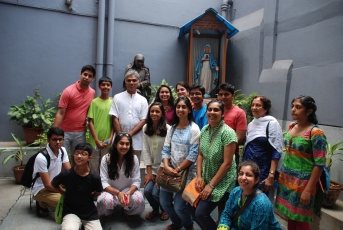August 9, 2015
Club 7, with Deba Uncle’s help, arranged a bus tour that transported us back 200 years in time. We were going to attempt to cover two to three centuries of history in a couple of hours. Our general bus route took us through Chowringhee Road, then through the Maidan, and finally to Dalhousie Square. A map below highlights our bus route. You’ll also find below historical information about each landmark.
Uncle and Deba Uncle reminded us of how Shri Ramakrishna and Swami Vivekananda must have wandered through some of these very streets, perhaps soaking in similar sites and sounds. Thanks to Mahendranath Gupta, we have an account of some of Shri Ramakrishna’s observations and experiences. With Deba Uncle’s help, we have tried to include some of these relevant conversations; they appear in italics.
* * *
The British ruled India for nearly two centuries. Calcutta was the central backdrop for the Company Raj and British Raj for nearly all of this time. During this period, Calcutta grew to become India’s first modern “metropolitan cosmpolis,” perhaps even the first in Asia. Calcutta was an important commercial center, and also the center of the Bengal Renaissance. The “Bengal Renaissance” referred to a period of revitalization of ancient philosophies and art, a period of social and religious reform and enthusiastic public discourse. Concurrently, western science, reasoning, and methodologies of scholarship highly influenced the Indian educated elite. It was in this social, political, and economic milieu that Shri Ramakrishna and Swami Vivekananda came to be. In this context, it is rather confounding to understand how Shri Ramakrishna, an “illiterate man” from rural Bengal, found himself continually surrounded by the Calcutta intelligentsia – scholars, zamindars, doctors, lawyers, educationists, etc. Their skepticism and questions mirror ours today. Shri Ramakrishna challenged their worldview and brought them face-to-face with ideas that paradoxically upended their idea of “modernity.” Using simple metaphors and with refreshing humility he spoke of Vedantic ideals in daily practice…
As we explored the historical quarters of the city and drove past beautiful buildings with stately architecture, the scenes of the 19th century came to life before us. The tour not only gave us a glimpse of that time, but it enabled us to better contextualize the phenomenon of Shri Ramakrishna and Swami Vivekananda.
Timeline of Important Events
1690 – Arrival of British East India Company
1757 – Battle of Plassey
1764 – Battle of Buxar – East India Company attains Diwani and Nizamat (right to collect land revenue and right to exercise criminal jurisdiction respectively).
1772 – 1850 – East India Company Raj
1772 – East India Company appoints Warren Hastings as 1st Gov General
1784 – Asiatic Society of Bengal founded by Sir William Jones
1828 – Raja Ram Mohan Roy founded what later evolved into the Brahmo Samaj
1830 – Foundation of what later became the Scottish Church College (SV’s college)
1836 – Birth of Shri Ramakrishna
1854 – 1st Railway line in India built (Calcutta to Hooghly)
1857 – Sepoy Mutiny/First War of Independence
1858 – End of control by East India Company. Power transferred to British Crown.
1861 – Birth of Rabindranath Thakur (Tagore)
1863 – Birth of Swami Vivekananda (SV)
1869 – Birth of Mahatma Gandhi
1877 – Queen Victoria declares herself “Empress of India”
1881 – SV first meets Shri Ramakrishna
1885 – Foundation of Indian National Congress (INC)
1886 – Shri Ramakrishna attains mahasamadhi
1893 – Swami Vivekananda comes to the US. Gandhi arrives in South Africa.
1902 – Swami Vivekananda attains mahasamadhi
1905 – Partition of Bengal under Lord Curzon’s (viceroy)
1911 – British move their capital to Delhi. Bengal Partition rescinded.
1913 – Tagore receives the Nobel Prize
1915 – Mahatma Gandhi returns to India.

Click on this link to open a larger map: Kolkata Bus Tour Map
1. Mother Teresa’s House (Nirmala Shishu Bhavan) – Please see previous post.
2. Rani Rasmani’s Jan Bazar Palace – Rani Rasmani founded the Dakshineshwar Kali temple, where Shri Ramakrishna served as the priest.
She was an exceptional example of woman leadership in the 19th century. After the death of her husband, a wealthy zamindar and social reformer, Rani Rasmani oversaw and expanded her husband’s business with the help of her son-in-law, Mathur Mohan Biswas (Mathur Babu). She was a philanthropist and an outspoken champion of the poor, often challenging unfair British regulations.
Though a Shudra according to conventional social stratification, Rani Rasmani defied social norms by building the Kali temple at Dakshineshwar. At first, society shunned the temple making it difficult for her to find a priest. Finally, Ramkumar, the eldest brother of Shri Ramakrishna, was appointed as the chief priest. Ramkumar served the temple for several years and eventually brought along his younger brother Gadadhar, later Shri Ramakrishna, to train for the priestly profession. After Ramkumar passed away, Rani Rasmani handed the responsibility of worshipping Mother Kali—the principal deity of the temple complex–to Shri Ramakrishna.
Rani Rasmani’s palatial home still stands in Janbazar.

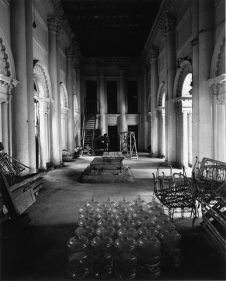
3. Metropolitan Building – Built in 1905 on of the busiest intersections of Chowringhee Road, the Metropolitan Building, with its neo-baroque architecture, epitomized fashionable shopping during the British Raj. It once housed Whiteways Laidlaw & Co., then Asia’s largest department store. With the help of World Monuments Fund, the building was restored beginning in 2003 and now is a commercial complex.


4. Chowringhee Road (now named Jawaharlal Nehru Road) – In the 18th century, this road was referred to as the “road leading to the Kalighat” and was one of the fifty-one Shaktipeethas. Running through the heart of Kolkata, Chowringhee Road was one of the first modern roads built in the city. Because of its proximity to the Hooghly, the area around Chowringhee Road was referred to as the Esplanade. Most of the Kolkata’s heritage structures are located within the Esplanade, including the Metropolitan Building (described above), which was known as the “Queen of Esplanade Square.”
During British Rule, this “Paris-esque boulevard” became associated with opulent British real estate. The English built grand mansions and stately complexes on Chowringhee, because of which Calcutta was once referred to as the “City of Palaces.” Some of the prominent landmarks that dot Chowringhee Road are: Metropolitan Building, Oberoi Grand Hotel, Indian Museum, Asiatic Society of Bengal, Geological Survey of India, and various heritage Chowringhee Mansions.




5. Grand Hotel – The Grand Hotel, is among the oldest luxury hotels in India. It was often known for its lavish parties and elite clientele. During World War II, it was appropriated by the British army and used as a station for British soldiers, housing as many as 4000 soldiers.

6. Indian Museum – The Indian Museum is one of the “oldest such foundations in Asia.” In 1796, the Asiatic Society of Bengal announced its intention to found a museum. The Asiatic Society Museum was founded in 1814 within the Society building. Later known as the Imperial Museum, and more commonly the Jadughar or Ajabghar, the museum was moved to a newly constructed building in 1875. It has among its archives, a rich collection of Persian, Mughal, and Rajasthani paintings, status and bronzes from antiquity, and even the Great Rock Edicts of Asoka and pillar inscriptions. It also houses the largest Indian coin collection that date from 5th century BCE to the present day. The Museum has recently partnered with the Google Culture Institute to make its exhibits available for 360-panaromic viewing online.



Shri Ramakrishna had visited the original Kolkata Museum, when it was housed within the Asiatic Society. Here are a few instances during which Shri Ramakrishna referred to the museum:
* * *
MASTER: “Once, a long time ago, I was very ill. I was sitting in the Kāli temple. I felt like praying to the Divine Mother to cure my illness, but couldn’t do so directly in my own name. I said to Her, ‘Mother, Hriday asks me to tell You about my illness.’ I could not proceed any farther. At once there flashed into my mind the Museum of the Asiatic Society, and a human skeleton strung together with wire. I said to Her, ‘Please tighten the wire of my body like that, so that I may go about singing Your name and glories.’ It is impossible for me to ask for occult powers.
In the context of Influence of company: MASTER (to the devotees): “I visited the museum once. I was shown fossils. A whole animal has become stone! Just see what an effect has been produced by company! Likewise, by constantly living in the company of a holy man one verily becomes holy.”
Geological Survey of India – (Located right behind the Museum.) The Geological Survey of India was established in 1851. It was the leading source of earth science information for the government and for industry. The institution can be traced to the 1836 Coal Committee and other organizations that lead coal exploration – coal was needed to power steam transportation in the empire.
Asiatic Society – Sir William Jones, the Chief Justice of Bengal and a well known “Oriental scholar” prior to coming to India, founded the Society in 1784. Sir William Jones recorded a memorandum of his plan of study and the subject of scholarship at the Society, “the laws of the Hindus and Mahomedans; the history of the ancient world; proofs and illustrations of scripture; traditions concerning the deluge; modern politics and geography of Hindusthan; Arithmatic and Geometry and mixed sciences of Asiaticks; Medicine, Chemistry, Surgery and Anatomy of the Indians; natural products of India; poetry, rhetoric and morality of Asia; music of the Eastern nations; the best accounts of Tibet and Kashmir; trade, manufactures, agriculture and commerce of India: Mughal constitution, Marhatta constitution etc.” The Asiatic Society became the first formal institution for “Oriental studies” and a pioneer for research in the field. For instance, “in [Sir William Jones’] 1786 presidential discourse to the Asiatic Society, he postulated the common ancestry of Sanskrit, Latin, and Greek, his findings providing the impetus for the development of comparative linguistics in the early 19th century.”
Some facts: The Asiatic Society library contains many rare archives including texts and manuscripts from Tipu Sultan’s library that the British acquired after they defeated the Mysore ruler. When the Indian Museum was founded, the Asiatic Society donated much of its archives to the Museum. …It wasn’t until 1829 that Indians were allowed membership. The Tagores were among the first members.
7. Birla Planetarium– The Birla Planetarium in Kolkata is Asia’s largest planetarium and the world’s second largest. It was the first of it’s kind in India and was inaugurated by Prime Minister Jawaharlal Nehru in 1962. The architecture is loosely based on the Buddhist stupa at Sanchi.
8. Victoria Memorial – The Victoria Memorial, which currently sits in the Maidan, was built in memory of Queen Victoria (UK Reign 1837-1901, Declared “Empress of India” in 1876). The memorial was built between 1906-1921.
The vision for the building was set by Viceroy Lord Curzon. Curzon wanted to build a grand public building, describing the idea as follows:
“Let us, therefore, have a building, stately, spacious, monumental and grand, to which every newcomer in Calcutta will turn, to which all the resident population, European and Native, will flock, where all classes will learn the lessons of history, and see revived before their eyes the marvels of the past.”
The cost of the construction amounted to one crore, five lakh rupees, all of which came from voluntary subscriptions from princes and the people of India. There is some distant resemblance to the Taj Mahal, which earned it the title of “Taj of the Raj.” Some say this was not entirely coincidental given Curzon led the restoration of the Taj Mahal.
Some facts: The memorial has historical artifacts such as a dagger belonging to Tipu Sultan, a cannon used in the Battle of Plassey, manuscripts by the famed Abu Fazal of Akbar’s court, and belongings of Warren Hastings, Dwarkanath Tagore, and Ishwar Chandra Vidyasagar. Lord Curzon had marble brought from the same Makrana quarries in Rajasthan that supplied Shah Jahan 


9. Kolkata Race Course -The Race Course was laid out in the Maidan in 1812 during the Company Raj, mainly for army officers. Maintained by the Royal Calcutta Turf Club which was founded in 1847, it is one of the largest horse race venues in India. During the British Raj, it became one of the leading horse racing organizations in India, and at one time even served as the governing body for all such sports in the sub-continent. The races, opened by the Viceroy of India, brought together the upper echelons of society and were a major component of the British elite’s social scene.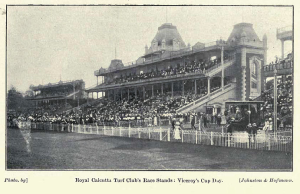
Fort William – The old Fort William was constructed in 1696 at the site of the General Post Office. It was seized by Shiraj-Ud-Daulah, then the Nawab of Bengal. However, following the murder of Nawab during the Battle of Plassey in 1758, a new fort was constructed under the order of Robert Clive of the British East India Company. The area around the fort was cleared to form the “Maidan.”
* * *
Once Ramakrishna went to see Fort William, the British fort in Calcutta. Just as he arrived by carriage, the Sikh regiment was marching there. When the soldiers saw him, they dropped their rifles on the ground and bowed down to him, shouting, “Victory to the guru!” The British commander‑in‑chief was nonplussed. When he asked the Sikh soldiers about their unusual behavior they replied that it was the custom of their religion to show respect for their guru in that manner. Thus Ramakrishna conquered the British fort by merely siting in his carriage. It was not even necessary for him to step out of the vehicle. This was truly amazing!
For the householders Sri Ramakrishna did not prescribe the hard path of total renunciation. He wanted them to discharge their obligations to their families. Their renunciation was to be mental. Spiritual life could not he acquired by flying away from responsibilities. A married couple should live like brother and sister after the birth of one or two children, devoting their time to spiritual talk and contemplation. He encouraged the householders, saying that their life was, in a way, easier than that of the monk, since it was more advantageous to fight the enemy from inside a fortress than in an open field. He insisted, however, on their repairing into solitude every now and then to strengthen their devotion and faith in God through prayer, japa, and meditation. He prescribed for them the companionship of sādhus. He asked them to perform their worldly duties with one hand, while holding to God with the other, and to pray to God to make their duties fewer and fewer so that in the end they might cling to Him with both hands. He would discourage in both the householders and the celibate youths any lukewarmness in their spiritual struggles. He would not ask them to follow indiscriminately the ideal of non-resistance, which ultimately makes a coward of the unwary.
10. Maidan – Similar to New York’s Central Park, the Maidan is the largest and oldest urban park in Kolkata. It was created by the East India Company military in order to clear the line of view for Fort William’s cannons. The park is located between the Hooghly (on the West) and Chowringhee (now Jawaharlal Nehru) Road.
Fort William, the Raj Bhavan (Governor’s House), Shaheed Minar, the Eden Gardens, Victoria Memorial, and the Kolkata Race Course are all located in the Maidan.
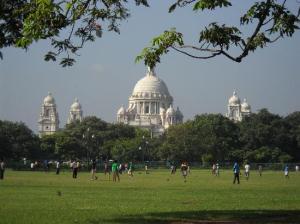
* * *
Master at the circus
Sri Ramakrishna, accompanied by Rakhal and several other devotees, came to Calcutta in a carriage and called for M. at the school where he was teaching. Then they all set out for the Maidan. Sri Ramakrishna wanted to see the Wilson Circus. As the carriage rolled along the crowded Chitpore Road, his joy was very great. Like a little child he leaned first out of one side of the carriage and then out of the other, talking to himself as if addressing the passers-by. To M. he said: “I find the attention of the people fixed on earthly things. They are all rushing about for the sake of their stomachs. No one is thinking of God.”
They arrived at the circus. Tickets for the cheapest seats were purchased. The devotees took the Master to a high gallery, and they all sat on a bench. He said joyfully: “Ha! This is a good place. I can see the show well from here.” There were exhibitions of various feats. A horse raced around a circular track over which large iron rings were hung at intervals. The circus rider, an Englishwoman, stood on one foot on the horse’s back, and as the horse passed under the rings, she jumped through them, always alighting on one foot on the horse’s back. The horse raced around the entire circle, and the woman never missed the horse or lost her balance.When the circus was over, the Master and the devotees stood outside in the field, near the carriage. Since it was a cold night he covered his body with his green shawl.
Necessity of spiritual discipline
Sri Ramakrishna said to M: “Did you see how that Englishwoman stood on one foot on her horse, while it ran like lightning? How difficult a feat that must be! She must have practised a long time. The slightest carelessness and she would break her arms or legs; she might even be killed. One faces the same difficulty leading the life of a householder. A few succeed in it through the grace of God and as a result of their spiritual practice. But most people fail. Entering the world, they become more and more involved in it; they drown in worldliness and suffer the agonies of death. A few only, like Janaka, have succeeded, through the power of their austerity, in leading the spiritual life as householders. Therefore spiritual practice is extremely necessary; otherwise one cannot rightly live in the world.”
MASTER (to the devotees): “I shall look upon them as the Blissful Mother Herself. What if one of them acts the part of Chaitanya? An imitation custard-apple reminds one of the real fruit. Once, while going along a road, a devotee of Krishna noticed some babla- trees. Instantly his mind was thrown into ecstasy. He remembered that the wood of babla-trees was used for the handles of the spades that the garden of the temple of Syamasundar was dug with. The trees instantly reminded him of Krishna. I was once taken to the Maidan in Calcutta to see a balloon go up. There I noticed a young English boy leaning against a tree, with his body bent in three places. It at once brought before me the vision of Krishna and I went into samādhi.
11. Red Road (Now Indira Gandhi Sarani) – The original Red Road was made in the 1720s. The name came from the color of the material that was used for paving. Construction for the current road began in 1820 under Colonel Watson. The road spans between the Raj Bhavan and Fort William. British used this road for state parades. Interestingly, during World War II, the road even served as a landing strip for fighter planes. Mother Teresa’s funeral procession by the Indian government made its way through historic thoroughfares of the city, including Red Road.

12. Shaheed Minar (loosely called the Monument, formerly known as Ochterlony monument) – The 158 ft minar or tower was originally built on the Esplanade by the East India Company in 1828 in memory of major General David Octherlony, the commander of the British East India Company, to commemorate soldiers that defended Delhi from the Marathas and also the British victory in the Anglo-Nepalese War (the result of the latter was that a third of Nepalese land was handed to the British, including present day Sikkim and Darjeeling).
The monument’s design was influenced by Egyptian, Syrian, and Turkish architecture. In 1969, the minar was rededicated to memorialize the Indian Independence Movement. It was then rechristened and called the “Shaheed (martyr) Minar (tower),” which means “martyrs’ monument”.
* * *
(To M. and Prankrishna) “Many people talk of Brahmajnāna, but their minds are always preoccupied with lower things: house, buildings, money, name, and sense pleasures. As long as you stand at the foot of the Monument, then so long do you see horses, carriages, Englishmen, and Englishwomen. But when you climb to its top, you behold the sky and the ocean stretching to infinity. Then you do not enjoy buildings, carriages, horses, or men. They look like ants…………………………………….
“The nearer you come to God, the more you feel peace. Peace, peace, peace-supreme peace! The nearer you come to the Ganges, the more you feel its coolness. You will feel completely soothed when you plunge into the river.
13. Akashvani Bhavan (All India Radio) – “Radio Broadcasting started in India in the early 1920’s. The first programme was broadcast in 1923 by the Radio club of Bombay. This was followed by setting up Broadcasting Services in 1927 with two privately-owned transmitters at Bombay and Calcutta. The Government took over the transmitters in 1930 and started operating them under the name of Indian Broadcasting Service. It was changed to All India Radio (AIR) in 1936 and it came to be known as Akashvani from 1957.” –Know India: Culture and Heritage, India.gov.In Website
It is obvious to us now that state control over all communication systems was certainly advantageous to the colonial government. Radio could also be used to “manufacture an illusion of political consensus.” Yet, just like with the development of the railway, telegraph, and postage system, the radio too played a role in sparking Indian national sentiment, “allowing latent ideas and attitudes to travel and ferment into broader political movements.” However, the development of the radio in India was deflected by turmoil on the ground and differences among organizing parties.


14. Eden Garden & Eden Garden Cricket Stadium – Eden Garden consists of the land between the Hooghly and the Raj Bhavan (Governor General’s House). In the 1840s, it belonged to the then Governor General Lord Auckland. Auckland’s sisters, Emily and Fanny Eden supervised the cleaning of the land, and opened it to the public as a recreational ground in 1841.
The Eden Gardens Stadium, located in Eden Garden, is the largest cricket stadium (in terms of capacity) in India, and the second largest in the world (second only to Melbourne) with a seat capacity of over 65,000.


15. Netaji Indoor Stadium (Eden Garden Cricket Stadium) – The stadium is the only indoor sports arena in Kolkata. It is a fully air-conditioned stadium and seats 12,000 people.
16. Babu Ghat – Babu means Bengali person of aristocracy or higher stratum of society. Babu Ghat was built out of the patronage of Babu Raj Chandra Das, Rani Rashmoni’s huband, in 1830. It is the second oldest ghat in Kolkata. Babu Ghat reminds us of an incident relating to Rani Rashmoni’s dealings with the British. British had imposed a tax on fishing activities on the Hooghly, threatening the livelihood of the local fisherman. The fisherman turned to Rani Rashmoni for help. In protest, the spirited Rani bought some land on the other side of the river and blocked river traffic with iron chains. The British were forced to concede with the Rani’s demands for her people.




17. Howrah Bridge (Now Rabindra Setu) – As far back as 1862, the Government of Bengal began researching the idea of building a bridge across the Hooghly. The Calcutta Port Trust was thus created in 1870, and the construction of the first bridge was completed in 1874. By 1905, it was evident that this bridge could not handle the load. Construction faced delayed because of WWI and WWII. As a result of WWII, steel that was supposed to be used for the construction was diverted; Tata Steel provided almost 90% of the necessary steel. Bridge construction was finally completed in 1942. The British did not open the bridge with much fun fanfare, fearing bombing by the Japanese. Howrah Bridge marked a engineering feat by the British Raj. The bridge is the 6th longest cantilever truss bridge in the world.
18. High Court – The Calcutta High Courtis the oldest High Court in India. It was preceded by the Supreme Court of Judicature at Fort William, which hosted the judiciary system from 1774 to 1862. The Calcutta High Court, built in 1862, was the first High Court in India and one of the three chartered courts in India (the others were the High Courts of Bombay and Madras). These were the highest courts for all cases in India until the establishment of the Federal Court of India in 1935. The current court building was constructed in 1872 (the prior Court existed on the Esplanade.)

 Swami Vivekananda, known as Naren in his youth, came from a family of lawyers. Naren’s great grandfather was a “Farsi lawyer” of the Supreme Court of Judicature at Fort William. Naren’s grandfather, Durga Prasad, worked in an Attorney’s office and was to become a partner in his father’s law firm, but he soon took up monasticism. Naren’s first cousin, Tarak Nath used to handle litigations for the famed Jorasankho Tagore family. Naren’s father too had a successful legal practice, and would travel to distant places such as: Lucknow, Lahore, Delhi, Rajputana, and Raipure. Even Naren was to complete his law studies, but was not able to due to the death of his father and the circumstances that this brought to his family.
Swami Vivekananda, known as Naren in his youth, came from a family of lawyers. Naren’s great grandfather was a “Farsi lawyer” of the Supreme Court of Judicature at Fort William. Naren’s grandfather, Durga Prasad, worked in an Attorney’s office and was to become a partner in his father’s law firm, but he soon took up monasticism. Naren’s first cousin, Tarak Nath used to handle litigations for the famed Jorasankho Tagore family. Naren’s father too had a successful legal practice, and would travel to distant places such as: Lucknow, Lahore, Delhi, Rajputana, and Raipure. Even Naren was to complete his law studies, but was not able to due to the death of his father and the circumstances that this brought to his family.
19. Town Hall – The Town Hall was constructed in 1814 as a public meeting space for “elite European gatherings.” The ground floor was open to the public to view paintings and sculptures while the second floor was used to host state events for the East India Company along with other receptions and balls.
In 1898, Jagdish Chandra Bose’s famous experiment was carried out at the Town Hall in front of the public. In this experiment, Bose ignited gunpowder and rang a bell at a distance using electromagnetic waves. It was the first experiment that demonstrated how communication signals could be sent without wires.
Tagore’s 50th and 70th birthdays were also celebrated at the Town Hall in Tagor’e presence.
Today the library at Town Hall houses rare books, journals, and manuscripts from the colonial period. The Kolkata Museum is located on the ground floor and the first floor hall is often used for lectures, exhibitions, cultural events, etc. ![The Town Hall [Calcutta] 1865](https://mahendrajani.files.wordpress.com/2016/08/the-town-hall-calcutta-1865.jpg?w=283&h=232)

20. Raj Bhavan – This grandiose structure was formerly known as the Governor’s House, and was the official residence of the Viceroy of India. Today it is the official residence of the Governor of West Bengal.
Construction for Raj Bhavan ran between 1799 and 1803. The Governor’s House was an imposing building, clearly built as a symbol of power and imperial success.

 This is reflected in the type of social gatherings that took place at the House. The first major event hosted in the Governor’s House was in 1802 during the anniversary of the Battle of Seringapatam, the battle in which Tipu Sultan was defeated. “The Governor General gave a breakfast to ‘above seven hundred of the principal ladies and gentlemen of the settlement’ and ‘on this occasion, the great apartments of the new Government House were opened for the first time.’“ The throne of the aforementioned Tipu Sultan actually sits in a room in Raj Bhavan, aptly named the “Throne Room”. (Below are pictures of the Throne Room and Ballroom, respectively.)
This is reflected in the type of social gatherings that took place at the House. The first major event hosted in the Governor’s House was in 1802 during the anniversary of the Battle of Seringapatam, the battle in which Tipu Sultan was defeated. “The Governor General gave a breakfast to ‘above seven hundred of the principal ladies and gentlemen of the settlement’ and ‘on this occasion, the great apartments of the new Government House were opened for the first time.’“ The throne of the aforementioned Tipu Sultan actually sits in a room in Raj Bhavan, aptly named the “Throne Room”. (Below are pictures of the Throne Room and Ballroom, respectively.)

 To understand the importance of the role of the Governor-General of Bengal, it is important to understand the structure of the British Government in India and the appointment of the Governor-General office. In 1851, the British designated four presidencies (provinces):
To understand the importance of the role of the Governor-General of Bengal, it is important to understand the structure of the British Government in India and the appointment of the Governor-General office. In 1851, the British designated four presidencies (provinces):
Bengal – In Calcutta … this was once the largest presidency.
Bombay – In Bombay (Now Mumbai)
Madras – In Madras (Now Chennai)
North-Western Provinces – In Agra
Until 1857, the Director of the East India Company appointed a Governor General. In 1858, after the 1857 uprising, the East India Company territories came under the direct control of the British Crown. As a result, from 1858 to 1914, it was the King of England that appointed the Governor General, henceforth known as the Viceroy of India. A Governor headed each presidency; all Governors were to report to the Viceroy, the chief officer in India. The Viceroy was to report to Parliament. For many years, the Governor of Bengal was concurrently the Viceroy of India.


* * *
Mani Mallick and Bhavanath referred to the exhibition which was then being held near the Asiatic Museum. They said: “Many maharajas have sent precious articles to the exhibition-gold couches and the like. It is worth seeing.”
MASTER (to the devotees, with a smile): “Yes, you gain much by visiting those things. You realize that those articles of gold and the other things sent by maharajas are mere trash. That is a great gain in itself. When I used to go to Calcutta with Hriday, he would show me the Viceroy’s palace and say: ‘Look, uncle! There is the Viceroy’s palace with the big columns.’ The Mother revealed to me that they were merely clay bricks laid one on top of another.
21. St. John’s Church – The church, built between 1784 and1787, was one of the first public buildings constructed by the British East India Company. The site of St. John’s Church was originally the burial ground of Calcutta’s “founder” Job Charnock and his family. Maharaj Nabakrishnadeb donated the land to Warren Hastings, who wanted to build St. John’s at this location. Lord Cornwallis* was present at its consecration ceremony. The church contains plaques and tombstones dedicated to prominent people associated with East India Company as well as many interesting memorials that date to the early British colonial period. One of these include the gravestone of the Company doctor, Dr. Hamilton, who saved the Mughal Emperor, as a result of which the emperor granted the Company free trading license.
Trivia – Supposedly the floor of Gaur was made from ruins of Gaur and ancient city in Bengal.
(*Cornwallis, a famous British General in the American War of Independence, was appointed as Governor General of Bengal and Commander in Chief in 1786. He is known not only for his defeat of Tipu Sultan, but also for the many reforms he made in the East India Company operations that solidified British rule in India.


22. GPO (General Post Office) – The GPO is notable for its imposing high domed roof (rising over 220 ft or 22 storied building) and tall iconic Corinthian pillars. Located in what was originally a famous British outpost named Fort William, the General Post Office (GPO) is the central post office of both the city of Kolkata and the state of West Bengal. The GPO was constructed in 1868, 91 years after William Hastings introduced the postal system to Kolkata. The GPO signified the coming of age of the postal system – a system that introduced India to large-scale, streamlined mail/parcel delivery – and one that reflected the modernization of India. It was the same system that handled Swamiji’s inspirational letters and important colonial government correspondences among other historic conversations and negotiations. The popular landmark continues to handle most of the city’s inbound and outbound mail and parcels.


23. BBD Bagh – BBD Bagh was once known as Dalhousie Square, named after Lord Dalhousie who served as the Governor General of India from 1847-1856. (Lord Dalhousie was infamous for his “Doctrine of Lapse” which forbid Indian rulers from adopting an heir in the absence of a natural heir. This measure allowed the British to annex the territories of such rulers.)
Dalhousie Square is located at the site of the old Fort William, which was constructed in 1696. The Square surrounds what was locally called the “Lal Dighi” or Red Pool. Lal Dighi was a water tank that was the source of drinking water for the nearby European residents until the 19th century. Its name referred to the reflection of the red bricks of the colonial buildings that were mirrored in the pool. Dalhousie Square was the seat of power during the British Raj. “In the eighteenth and nineteenth centuries, Calcutta was the capital of British India and Dalhousie Square was the city’s financial, social, and political nucleus.”
Dalhousie Square was the seat of power during the British Raj. “In the eighteenth and nineteenth centuries, Calcutta was the capital of British India and Dalhousie Square was the city’s financial, social, and political nucleus.”
In and around the square, you’ll find important administrative buildings such as:
Writer’s Building (1777)
St. John’s Church (1787)
Kolkata Town Hall (1814)
Currency Building (1833)
Bengal Chamber of Commerce and Industry (1853)
General Post Office/GPO (1868)
Kolkata Port Trust (1870)
Central Telegraph Office/CTO (1876)
East Indian Railway headquarters (1879)
Calcutta Stock Exchange (1908)
Royal Insurance Building (1911) After India’s independence, the Square was renamed “BBD Bagh” after three the young martyrs Benoy, Badal, and Dinesh that were hung by the British for their protest against the partition of Bengal in 1905.
After India’s independence, the Square was renamed “BBD Bagh” after three the young martyrs Benoy, Badal, and Dinesh that were hung by the British for their protest against the partition of Bengal in 1905.
Many of the original buildings from the Square have been knocked down by developers to create office spaces. Recently, 55 buildings around Dalhousie Square have been declared to be heritage sites by the World Monuments Fund. Many of these offices are important political and commercial offices of Bengal.


24. Writer’s Building – By the time the East India Company arrived in Bengal, it was already in existence for nearly a hundred years and had presence in various cities in India. Under Governor Warren Hastings, the Company underwent many major reforms, one of which included an effort to consolidate the administration and staff. It was in this context that Hastings conceived of the Writer’s Building. By 1778 the building was ready for use.
The Writer’s Building was named after the labor force that essentially became the operating system for colonial rule. Employees of the Company were organized under a very strict layered hierarchical structure. “Writers” ranked just above the lowest position (that of the apprentice). They were junior clerks or scribes, and their job was to keep all the accounts and to correspond with London. It was tedious work to keep all the ledgers organized and updated and creating hand written duplications of important documents. The working conditions weren’t entirely pleasant, yet, there was no dearth of candidates for the job. The Company attracted young men, as young as 16, who saw the job openings as their key up the social and economic ladder. The Writer’s Building served as the training ground for these workers. In 1800, the College of Fort William, founded to train the writers in Persian, Sanskrit, and Hindi, was moved to the Writer’s Building complexes. Initially, the writers were expected to study, live, and work in the building during their probationary period of 5 years, after which they could earn the opportunity to slowly move up the ranks.
The operations conducted in the Writer’s Building, especially after the significant reforms introduced by Hastings, were exemplary of an efficiently managed colonial empire. Hastings laid the foundation for what later evolved into the Indian Civil Service.



25. Tipu Sultan Shahi Mosque –Tipu Sultan’s youngest son, Prince Ghulam Mohammand Sultan Khan, built this mosque in 1832 in memory of his father, Tipu Sultan of Mysore.
Tipu Sultan was known for his fierce resistance to the British in the Anglo-Mysore Wars – battles in which Tipu Sultan allied with the French. There are controversial accounts of Tip Sultan’s rule, though modern scholarship attributes this to British historians from that era. In 1799, joint Maratha and British forces defeated Tipu Sultan in the fourth Anglo-Mysore War. After his death, his entire family was exiled. They were later brought to Calcutta by the British in 1806.


26. Bhim Chandra Nag’s Sweet Shop – This famous sweet shop dates back to 1826. Shri Ramakrishna especially loved Bhim Chandra Nag’s sandesh sweet.
“According to Haradhan Nag, an aged scion of Kolkata’s oldest sweet shop, Bhim Chandra Nag, [Rani Rashmoni] is said to have bought over a ton of SANDESH from the confectioner, for the celebration of its inauguration. …whenever, Rani Rashmoni, went to Dakshineshwar she invariably bought two big baskets of Bhim Chandra Nag sweets–one for the goddess Kali and other for Ramakrishna who would then apparently share them with his disciples.”
Birth of another Bengali Sweet dessert item “Ledikeni” – Lady Canning was the wife of the Lord Canning, the last Governor General of the East India Company, and later the first Viceroy when the British Crown took over in 1857. On the eve Lady Canning’s birthday, Lord Canning’s men came to Bhim Nag’s shop and ordered a special sweetmeat, which would be entirely different in shape and size than the existing range of sweets and would also outclass them in taste The Nags after pondering over it for days made a new kind of sweetmeat, much above the expectation of Canning’s men. It was partially a ‘Pantua’ and partially a ‘Lancha’. It resembled both to some extent but at the same time, was different from them. From the name of Lady Canning, this sweet came to be known in Bengal as “ledikeni” and is very popular even to this day.
Sources Include
Free Time / Shopping Time:
Many of our 91 pilgrims were coming to Kolkata for the first time. Kolkata is a big city and had many attractive things to offer in terms of shopping, etc. While we had kept no time for shopping as this was strictly a pilgrimage, our bus tour arrived at Hyatt one hour earlier than it was planned. Thus, everyone welcomed an hour of free time before our 12:30 lunch. People had choices to relax, to go for shopping, or start packing for our departure.
A group of about 20 uncles, aunties, and students went to a street market in Kolkata about 20 minutes away from our hotel to do some afternoon shopping. Surrounded by tea stands, purse vendors, and an array of saree stores to choose from, they walked around like tourists for almost an hour going from shop to shop, collecting bags of new outfits and souvenirs along the way.



Special Thanks to Club7 Members:
During our, once again, wonderful meal at Topaz and Sapphire, Mahendra Uncle came up to the podium and wished to express his, and our, thanks to Club7 for going above and beyond in making this trip the lifetime memory that it was.


Every aspect of Club7’s thorough work was shown during our trip, from the constant water bottles supplied at every corner, to the hotel booking, meal organizations, extremely skillful bus drivers, and comfortable buses. Club7 members expressed their joy for having us and gave us hearty welcome for whenever we wished to come back.




After this, we all went to our rooms to get ready to visit Belur Math one last time.
This blog claims no credit for any images posted on this site unless otherwise noted. Images on this blog are copyright to its respectful owners. If there is an image appearing on this blog that belongs to you and you do not wish for it appear on this site, kindly contact us with a link to the said image.
(Thanks to Nisha Parikh for writing this post and Ronak Parikh for editing. Thanks to Deba Uncle for creating the Bus Tour Map and providing us the information that connected the incidences and conversations from Shri Ramakrishna’s life to the Bus Tour landmarks.)




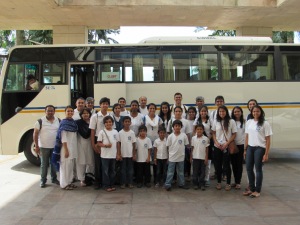
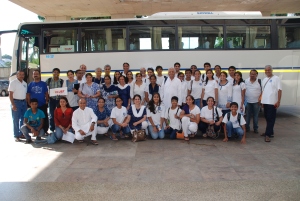



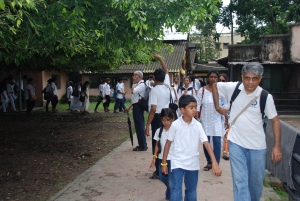






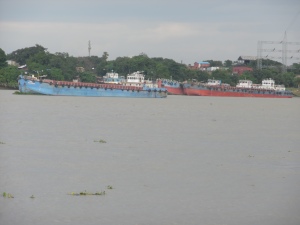
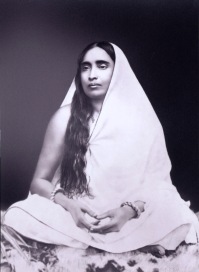
















































![The Town Hall [Calcutta] 1865](https://mahendrajani.files.wordpress.com/2016/08/the-town-hall-calcutta-1865.jpg?w=283&h=232)




































